
Dry-fried lotus root strips are a flavorful and aromatic Sichuan dish. They have a golden and crispy exterior, while being tender and juicy on the inside. Each lotus root strip is carefully selected and prepared, combined with unique spices and chili peppers, then stir-fried at high heat to infuse them with rich flavors and aromas. When you take a bite, the crispy outer layer instantly bursts in your mouth, while the inner lotus root meat is tender and succulent, providing a satisfying texture. This is an irresistible delicacy in Sichuan cuisine.
Ingredients for Dry-fried lotus root strips:
| Lotus root | 500g |
| Ginger | 6g |
| Garlic | 6g |
| Scallion | 5g |
| Coriander | 5g |
| Sichuan Pepper | 5g |
| Egg | 50g |
| Salt | 2g |
| Aginomoto | 1g |
| Sugar | 1g |
| White sesame seed | 2g |
| Pepper powder | 1g |
| Dried chilli | 5g |
| Cornstarch | 10g |
Step:
1.First, let’s prepare the ingredients: one section of lotus root. Peel off the outer skin of the lotus root and place it in a bowl. Pour in clean water to thoroughly rinse it, ensuring that any impurities on the surface are removed. Next, cut the lotus root into sections and then continue slicing it into thin pieces. Take these lotus root slices and cut them again to form uniform strips. Finally, place the sliced lotus root strips in a bowl and set aside. This preparation step ensures the cleanliness and convenience of cooking the lotus root. By cutting the lotus root into even strips, we can better control their cooking time and texture. It also helps the lotus root absorb the flavors of other seasonings, resulting in a more delicious dish.
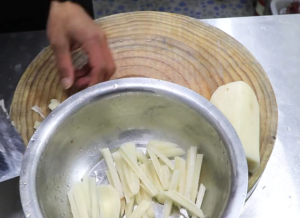
2.During the ingredient preparation process, we also need to handle some seasonings. First, take a piece of ginger and flatten it with force, then cut it into small diced pieces. This method helps release the aroma and flavor of the ginger, allowing it to blend better in the cooking process. Next, take three cloves of garlic, flatten them, and finely chop them. Place the ginger and garlic in the same bowl for later use. Preparing the ginger and garlic enhances the flavor and texture of the dish. Flattening the ginger and garlic helps bring out their natural aromas and seasoning properties, allowing them to better infuse into the cooking. As a result, the final dish will have a rich ginger-garlic flavor, adding layers and textures to the food.
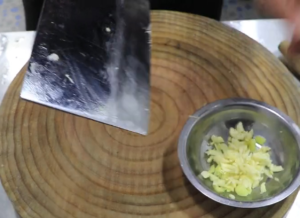
3.Next, we also need to prepare a small bowl. In this small bowl, add a handful of Sichuan peppercorns and dried chili peppers as seasoning. Sichuan peppercorns and dried chili peppers are commonly used spices that can add unique flavors and spiciness to dishes. Sichuan peppercorns provide a numbing and spicy sensation, while dried chili peppers bring a rich spiciness. By placing them in the small bowl for later use, we can add an appropriate amount of Sichuan peppercorns and dried chili peppers during the cooking process to adjust the flavor and spiciness of the dish.
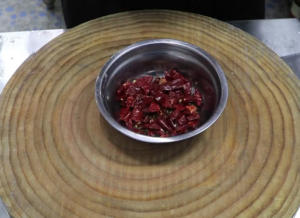
4.Continuing with the preparation of condiments, we need to handle some coriander and spring onions. First, cut three spring onions into segments and place them in a small bowl prepared earlier. The strong aroma of spring onions will add a unique flavor to the dish. Next, take an appropriate amount of coriander, cut it into small sections, and mix it with the spring onions. Coriander has a fresh taste and herbaceous aroma, which can enhance the texture and visual effect of the dish. Additionally, we also need to add a handful of white sesame seeds. White sesame seeds can add fragrance and a crispy texture to the dish while being a nutritious ingredient.
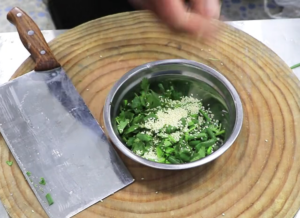
5.With the ingredients ready, let’s further process the lotus root. Crack an egg into the sliced lotus root and stir it evenly with chopsticks. Then, add an appropriate amount of cornstarch, continuing to stir until the starch coats every piece of lotus root, preventing them from sticking together.
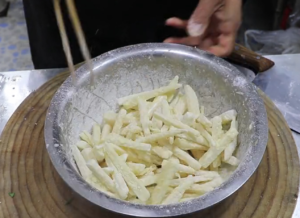
6.Next, we’ll deep-fry the lotus root. Heat oil in a pan until it reaches about 50% of its smoking point. Gently shake off any excess starch from the lotus root and place them individually in the pan. The heat will quickly set the lotus root, so gently shake the pan and use a spoon to continuously stir and prevent the lotus root from sticking to the bottom. If any pieces stick together, use the spoon to separate them. Fry on low heat for about 3 minutes or until the lotus root turns golden yellow on the surface. Once done, remove them from the oil.
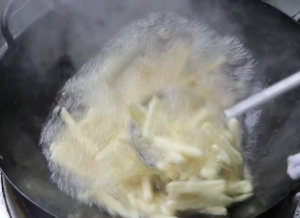
7.During the cooking process, next we need to raise the oil temperature to about 70% hot and perform a second frying. Use high heat to quickly fry the lotus root for about 20 seconds, then pour out the ingredients and drain the excess oil. Through the second frying, the appearance of the lotus root will become brighter with a golden crispy skin, increasing its visual appeal. Additionally, the second frying will further enhance the crispiness of the lotus root, making it even more enjoyable to eat. By using high heat and quick frying, the lotus root can be fried to a golden color quickly, while maintaining its tenderness and moisture inside. Once the second frying is done, pour out the fried lotus root and control the oil drainage to reduce greasiness, making the dish more refreshing and delicious. This second frying not only makes the lotus root visually appealing but also gives it a crispy texture, providing a wonderful eating experience.
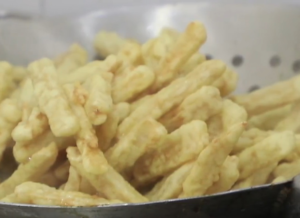
8.Leave some oil in the pan, heat it up, then add Sichuan peppercorns and dried chili peppers. Be cautious not to overheat the oil and burn the peppers. Stir-fry them to release their spicy and fragrant aroma. Add ginger and garlic, stir-fry until fragrant, then add in the fried lotus root. Reduce the heat to low, continuously stir-fry for 1 minute, allowing the lotus root to absorb the spicy flavors. Sprinkle in 2 grams of salt, a small amount of Aginomoto, 1 gram of pepper, and a little sugar. Continue stir-frying to evenly coat the lotus root with the seasonings.
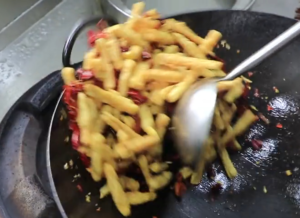
9.In the final stage of cooking, pour the previously prepared scallions, cilantro, and white sesame seeds into the pan and stir-fry them together to mix evenly. By stir-frying the scallions, cilantro, and white sesame seeds with other ingredients, their aroma and flavor can better blend into the whole dish, adding a rich taste. At the same time, stir-frying ensures that the ingredients are evenly distributed on the crispy lotus root slices, creating an appealing presentation. Once the scallions, cilantro, and white sesame seeds have been thoroughly stir-fried, remove the dish from the heat and get ready to plate it. This dish of lotus root not only looks enticing with its crispy texture but also carries the fragrance of scallions and sesame seeds, which significantly enhances the appetite. Now, you can carefully arrange them on a plate and savor the delicious lotus root dish!
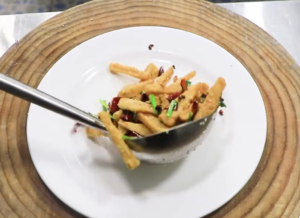
Tips:
1.When deep-frying lotus root slices, it is important to ensure that the oil temperature is moderate and not too high. This prevents the outer layer from getting burnt while the inside remains undercooked. Also, be mindful of the frying time to avoid overcooking the lotus root, which can make it dry.
2.During the stir-frying process, the lotus root slices will release some moisture. In the last few minutes, you can increase the heat to evaporate the moisture quickly, resulting in a drier and crispier texture.
3.When plating the dry-fried lotus root slices, handle them with care to maintain their integrity as much as possible.
Dry-fried lotus root slices are like a carnival of textures, with their crispy exterior dancing on your taste buds while the interior remains tender and juicy. It’s a representation of life’s rhythm – firm on the outside, soft on the inside, achieving a perfect balance. The dance of seasonings leaves a deep impression on your palate, playfully leaping and twirling, sometimes fiery and passionate, other times refreshing like a breeze. Each bite of dry-fried lotus root is a feast for the taste buds, and each chew represents our love and anticipation for life.

